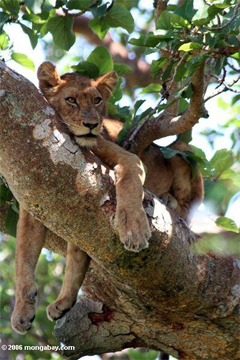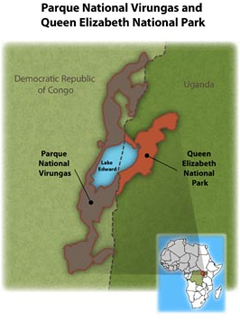The war-torn frontier between Uganda and the Democratic Republic of the Congo has prey to support more than 900 lions, but conservationists must act soon to protect the big cats from poaching and poisoning by livestock herders, report researchers writing in the journal Oryx.
The study, which was conducted by Adrian Treves of the University of Wisconsin-Madison and colleagues from Wildlife Conservation Society and the Panthera Foundation, relied on aerial surveys of lion prey — buffalo, warthog, waterbuck and other ungulates — which were then used to estimate the region’s potential lion population. The forecasts closely matched results from earlier ground surveys in Uganda’s Queen Elizabeth National Park where lions have been relatively well-protected, though their abundance has been slipping in recent years despite growing prey numbers.
 Queen Elizabeth National Park (QENP) is famous for its famous tree-climbing lions, a population that spends an unusual amount of time in trees. Photo taken in QENP by Rhett A. Butler  A new modeling study led by UW-Madison environmental studies professor Adrian Treves has found that, taken together, Parque National Virungas in the Democratic Republic of the Congo and adjoining Queen Elizabeth National Park in Uganda could hold up to 905 individuals of the threatened African lion. This suggests that the border region between the two countries could become the stronghold, or largest population, of lions in central Africa, but only if immediate conservation steps are taken. Illustration and caption courtesy of the University of Wisconsin-Madison Communications |
Outside the the park, lions face threats from pastoralists seeking to protect their livestock. Meanwhile in Congo’s Virunga National Park civil strife makes it difficult to monitor and conserve wildlife — predators and prey alike.
Still conservationists are hopeful that protective measures and outreach programs to help pastoralists reduce livestock losses to lions could turn the area into one of a “stronghold” for African lions.
“Those two protected areas that straddle the frontier could be the stronghold for lions in central Africa – the largest population,” said University of Wisconsin-Madison environmental studies professor Adrian Treves, the study’s lead author. “Therefore, (the population) is critically important, because the lion is now considered threatened throughout Africa.”
“We’re providing a vision of what could be,” he continued. “Uganda could maybe have a third of those 900-plus lions, and they’re an incredible source of tourism revenue. So we’re hoping that’s an incentive the government will respond to.”
“I don’t want to see lions disappear from Queen Elizabeth National Park the way that hyenas almost did, and the way cheetahs were eliminated from parts of Uganda. That’s a fate we need to avoid.”
Adrian Treves, Andrew J. Plumptre, Luke T.B. Hunter and Joel Ziwa. Identifying a potential lion Panthera leo stronghold in Queen Elizabeth National Park, Uganda, and Parc National des Virunga, Democratic Republic of Congo. Oryx , Volume 43, Issue 01, January 2009, pp 60-66 doi:10.1017/S003060530700124X
Related articles
Lion die-offs in Africa linked to global warming
(06/26/2008)
Scientists have linked climate shifts in East Africa to die-offs in lion populations in 1994 and 2001. The research is published in the open-access journal PLoS ONE.
Africa’s lions are disappearing
(03/25/2008)
The lion is Africa’s best known carnivore. Once widely abundant across the continent, recent surveys show that lion populations have plunged from over 100,000 individuals to around 23,000 over the past century. The reason? Lions are poisoned, shot, and speared by locals who see them as a threat to livestock. While lion populations in protected areas remain relatively healthy, conservationists say that without urgent measures, lions may disappear completely from unprotected areas. The Kilimanjaro Lion conservation Project is working to avoid this fate by developing practical measures to encourage coexistence between people, livestock and predators. Key to the effort is reducing livestock losses to lions. Leela Hazzah, a field researcher with the project, says the “Lion Guardians” program at Mbirikani Ranch in Kenya has proved remarkably successful: not a single lion has been killed since its inception in November 2006. The program employs Maasai warriors to monitor lions and help local communities prevent attacks on livestock.
Saving big cats depends on science, practical interventions
(05/21/2007)
Big cats are some of Earth’s largest and most threatened predators. Long persecuted as perceived threats to livestock and humans, hunted for their skins and purported medicinal values, and losing critical habitat to deforestation and conversion for agriculture, big cat populations have dwindled around the world for the past century. Given these trends, it should come as no surprise that big cats have become the focus of conservation efforts. Not only are large predators often the most vulnerable to human pressures and the first to disappear from ecosystems, but efforts to conserve them effectively help protect thousands of other species that share their habitat. At the forefront of these efforts in Dr. Luke Hunter, a biologist with the Wildlife conservation Society (WCS) where he heads their Great Cats Program. In a May 2007 interview with mongabay.com, Hunter discussed strategies for conserving carnivores and offered insight for students interested in pursuing careers in conservation science.